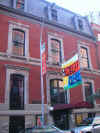| New York
Architecture Images-New York Architects Henry Hobson Richardson |
|

|
1838–86, American
architect, b. St. James parish, La., grad. Harvard, 1859, studied at the
Ecole des Beaux-Arts; great-grandson of Joseph Priestley. He was a major
representative of romanticism in American architecture and was noted for his
revival of Romanesque design. After employment in Paris, he began practice
(1866) in New York City but moved to Brookline, Mass., in 1874. Trinity
Church in Boston (1872–77) was his first monumental work; its French
Romanesque design was a departure from the Gothic revival that controlled
contemporaneous American architecture. In it and in subsequent works
Richardson developed a free and strongly personal interpretation of
Romanesque design. The style, known as Richardson Romanesque, spread and won
many followers, exerting a great influence upon the building arts of the
period, especially in the young, growing cities of Chicago, Cleveland,
Cincinnati, and St. Louis. Richardson's buildings showed strength,
simplicity, and a skillful employment of varied materials. In his country
houses of wood he produced a distinct American type. He elevated the
position of the minor crafts in his work, and to artists such as Augustus
Saint-Gaudens and John La Farge he entrusted the important units of
decoration. Among Richardson's principal works are the New Brattle Square
Church, Boston; public library, Woburn, Mass.; courthouse and jail,
Pittsburgh; Sever Hall and Austin Hall, Harvard; parts of the state capitol
at Albany, in association with Eidlety and Olmsted; Glessner House, Illinois
Institute of Technology; and the Marshall Field wholesale store, Chicago.
See H. R. Hitchcock, The Architecture of H. H. Richardson and His Times (1936, rev. ed. 1961); J. K. Ochsner, H. H. Richardson: Complete Architectural Works (1982); J. F. O'Gorman, H. H. Richardson (1987) and Living Architecture (1997). |